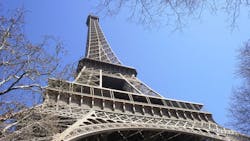Eiffel Tower Gets Lift from Hydraulics
This file type includes high-resolution graphics and schematics when applicable.
Whether you view the Eiffel Tower up close or from afar, it may be the most impressive man-made structure in the world. Most of its nearly 20,000 visitors per day view the Tower from the outside, but those exploring the inner structure witness a different experience. The view inside is further enhanced by elevators that whisk visitors to different levels to learn more about the landmark, enjoy breathtaking views from dizzying heights, and even take in a casual meal.
The elevators have been an integral part of the Eiffel Tower from the beginning. In fact, the Tower originally contained five hydraulic elevators that used steam engines as prime movers. The hydraulics were updated in 1899 and retrofitted with electric motor drives in 1912. Of course, several upgrades occurred after that. The elevators travel a combined 103,000 km (64,000 mi.) annually, so longevity and reliability carry a high priority—with safety, of course, topping them both.
Two of the original hydraulic elevators have undergone five upgrades through the years, and the two in the Tower’s west pillar were completely replaced in 2008. But they are still hydraulic, and they operate much like the original, simple-functioning versions of the machines.
Ingenious Engineering
The project leader for modernizing the elevator hydraulics was Dr. Olivier Ismeurt. Early on, he admired the yellowed, detail drawings of the components. But there were two shortcomings. First, the drawings did not show the overall hydraulic system. Second, the original condition of the elevators was no longer present following alterations made in the 1980s. Together with his team and the operating company Société d'Exploitation de la Tour Eiffel (SETE), he examined and reconstructed the original technical solution from the early days of industrial hydraulics.
Bosch Rexroth was instrumental in modernizing the complete hydraulic system of the elevator in the west pillar. The indirect hydraulic drive now in use follows Gustave Eiffel’s original design idea. Ismeurt was impressed with the “highly reliable solution” developed by the engineers more than a century ago, especially considering their limited calculation and production methods.
Energy Use Cut by 25%
This is in stark contrast to the tools available for the elevator upgrade. Bosch Rexroth design experts used simulation software to check the static and dynamic behavior of the entire system (comprising the hydraulic, mechanical, and control systems) before anything was installed. Therefore, the entire team was confident that the sizing and function of all hydraulic components—and the overall system—would meet or exceed expectations.
The new hydraulic system follows the original design configuration with two lift cylinders and three pressure-storage cylinders (accumulators). However, unlike the original system, valves do not control the ascent and descent motions. Instead, maximum speed, acceleration, and deceleration are controlled by variable-displacement pumps. As a result, the elevator, which today carries up to 1,000 passengers per hour, consumes about 25% less energy than the historical design.
One particular challenge was placement of the hydraulic power unit—it had to be housed in a cellar, which could only be accessed through a small freight elevator. This meant technicians had to partially disassemble the larger and heavier components and reassemble them inside the cellar.
Accessing the machinery room, in which the cylinder had to be installed, was no picnic either. “I will certainly never forget how the 18-meter-long (59 ft.) cylinders were lowered with centimeter-like precision into the machinery room,” recalls Olivier Soret, hydraulics technician at Bosch Rexroth, who was responsible for the commissioning of the Eiffel Tower hydraulics.




